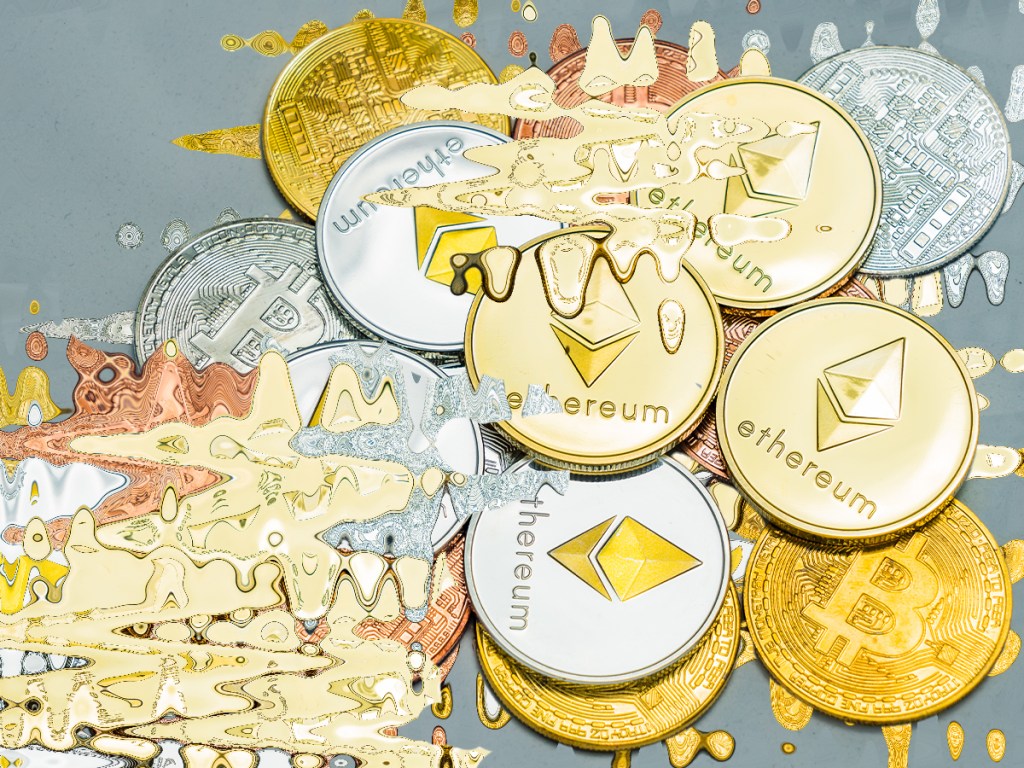So, cryptocurrency trading caught your interest? Keen to try buying and/or trading some crypto? The good news is, it’s easier than ever before. Cryptocurrency trading is like joining a cool party where you can make (or lose) money by speculating on the price movements of digital currencies. Once you’re in this space, there are tonnes of people to follow, tonnes of news sites dedicated to the pursuit, and a lot of truly fascinating things to learn about the crypto industry. And we are here to explain the steps on how to get started.
In this guide
In this guide, we will break down the basics of crypto trading in a way that’s easy to understand.
Cryptocurrency trading is similar to trading stocks on the stock market, but instead of buying and selling company shares, you’ll be buying and selling digital currencies like Bitcoin, Ethereum, or XRP. Much like the traditional stock market, the goal is to buy at a lower price and sell at a higher price in order to make a profit. This be done in rapid fashion, or you can buy some crypto and just hold onto it with the hope that the price will rise significantly over time.
Crypto trading isn’t a guaranteed way to make money, it should be said. It definitely involves risks. So, start small and only invest what you can afford to lose.
What is cryptocurrency trading?
Cryptocurrency trading is the process of buying and selling digital currencies. Here are some basic things you need to know about first.
Cryptocurrency Exchanges: Trading mostly takes place on online platforms called cryptocurrency exchanges. These exchanges are digital marketplaces where crypto enthusiasts can buy and sell different cryptocurrencies using Australian dollars (or other fiat currencies).
Wallets: Before you start trading, you’ll need a digital wallet to store your crypto. It’s like an online bank account where you can keep your crypto securely.
Buying Cryptocurrencies: Once you have a wallet and have uploaded some Australian dollars, you can choose which crypto you want to buy. Research different cryptocurrencies, and their potential for growth. Then, you can place an order on the exchange to buy a specific amount of that crypto.
Holding or Selling: After you buy the crypto, you can hold onto it, hoping its value will increase over time. The other option is to sell it when you have made a profit. If you need the money back immediately, you may have to sell it at a loss. You can’t always expect the price to rise!
Market Volatility: Cryptocurrency prices can change rapidly. They can go up and down a lot in a short period. You can make a lot of money if the price goes up, but you can also lose money if the price goes down.
Research: Successful cryptocurrency trading requires research. Make sure you understand the things that influence crypto prices, like market trends, news and world crises, and tech developments. Read up on strategies and risk management techniques.

Buying and selling cryptocurrencies via an exchange
Australians who want to buy and sell crypto can follow this guide:
Choose an Exchange: Choose a cryptocurrency exchange that operates in Australia. Some popular exchanges in Australia are Coinspot, CoinJar, Swyftx, Luno, and Binance Australia (Binance Australia, at the time of writing, were having trouble with Australian dollar purchases, however you can still use a credit or debit card to buy crypto on the platform). Look for exchanges that have a user-friendly interface and good security.
Sign Up and Verify Your Account: Log onto the exchange’s website and sign up for an account. You will probably need to verify your identity.
Set Up a Digital Wallet: Most exchanges provide built-in wallets for storing your crypto. But it’s a good idea to have a separate digital wallet, independent of the exchange, for added security. (Exchanges can get hacked, or go bankrupt, and you could lose all your crypto on the exchange.) You can choose from various wallet options like hardware wallets (physical devices), software wallets (mobile or desktop apps), or online wallets (web-based).
Deposit Funds: Once your account is verified, you’ll need to upload funds into your exchange account. In most cases, you can deposit money via bank transfers, debit/credit cards, or with with other cryptocurrencies.
Cryptocurrency
Choose the Cryptocurrency: Now that you have funds in your account, choose the crypto you want to buy. Obvious selections are Bitcoin (BTC), Ethereum (ETH), and Ripple’s XRP, or you can buy memecoins like Dogecoin (DOGE), Shiba Inu (SHIB), or Pepe (PEPE). Research the cryptocurrencies and their prices before making a decision. Consider factors like their potential for use in the real world, technology, and market trends.
Place an Order: On the exchange, look for the “Buy” or “Trade” section. Enter the details of your purchase, including the amount of crypto you want to buy and the price you want to pay. Here is the interesting part. You can place an order to buy a crypto instantly at the current price, or you can place a limit order to specify the price at which you want to buy.
Monitor and Sell: Once you’ve bought the crypto, it will appear in your exchange account or wallet. You can track its value over time using the exchange’s charts. When you decide to sell, go to the “Sell” or “Trade” section, and follow the instructions.

How do cryptocurrency markets work in Australia?
Cryptocurrency markets in Australia work in a similar way to crypto markets in other countries.
Cryptocurrency Exchanges: Cryptocurrency exchanges are the main platforms where buyers and sellers trade digital currencies. There are multiple native Australian exchanges, and there are also foreign exchanges that offer services for Australian customers.
Account Setup and Verification: To start trading on a cryptocurrency exchange in Australia, you’ll need to undergo a verification process to comply with Know Your Customer (KYC) and Anti-Money Laundering (AML) regulations. This process involves submitting ID like a passport or driver’s license.
Deposit Funds: After your account is verified, you can deposit funds. Most Australian cryptocurrency exchanges offer various deposit options, including bank transfers, credit/debit cards, and sometimes even alternative payment methods like POLi or PayID.
Trading Pairs: Cryptocurrency trading in Australia is carried out using trading pairs. A trading pair represents the two cryptocurrencies you can trade against each other. For example, the BTC/AUD trading pair allows you to buy or sell Bitcoin using Australian dollars. Different exchanges offer different trading pairs, so check first if the exchange you have chosen can carry out your buy or sell order.
Placing Orders: There are generally two types of orders: market orders and limit orders. A market order allows you to buy or sell cryptocurrencies at the current market price. A limit order allows you to set a specific price at which you want to buy or sell. You can choose the order type based on your trading strategy.
Fees: Cryptocurrency exchanges in Australia charge fees for trading. These fees can include deposit/withdrawal fees, and network fees for certain cryptocurrencies. Be sure you know the fee structure of the exchange you’re using and factor them in.
Security: Security is mega-important when using cryptocurrency exchanges. Reputable exchanges have security measures like two-factor authentication (2FA), encryption, and cold storage of funds (where the crypto is stored offline so it can’t be hacked easily). Passwords are a big deal, so use strong, unique passwords.
Regulations and Compliance: Cryptocurrency trading is legal in Australia, and any profits made are potentially taxable. Cryptocurrency exchanges in Australia are subject to regulations and compliance requirements set by regulatory authorities like the Australian Securities and Investments Commission (ASIC) and the Australian Transaction Reports and Analysis Centre (AUSTRAC). These regulations aim to prevent fraud, money laundering, and ensure the security of user funds.

What moves cryptocurrency markets?
Just like in any market, cryptocurrency prices in Australia can go up and down. Here’s why.
Supply and Demand: When more people want to buy a cryptocurrency, its price tends to go up. But if many people are selling, the price may go down.
News: World events can have a big impact on crypto markets. Positive news like government regulations supporting crypto can drive up prices. Negative news, like hacks or government crackdowns, can cause prices to drop.
Market Sentiment: How people feel about crypto can have an affect on prices. If people feel that cryptocurrencies have a bright future, prices might go up as more people buy. However, if people become worried about the economy or about the future of crypto, prices might fall, as more people sell.
Technological Developments: Tech advances in the cryptocurrency industry can influence prices. If a new feature comes along that makes it easier to use, then the price can go up.
Celeb mentions: If celebrities mention cryptocurrency, this can send the price shooting up, in the way that whenever Elon Musk mentions Dogecoin, the effect on the price is almost immediate.
What is a lot in cryptocurrency trading?
A “lot” refers to a standardised unit of measurement for buying or selling cryptocurrencies. It determines the quantity of cryptocurrencies you’re trading. Different exchanges might have their own terms for lots, such as “coin size” or “contract size.”
The size of a lot can vary depending on the crypto and the exchange. Some cryptos are traded in smaller lot sizes, while others are traded in larger lot sizes.
As an example, if you are trading Bitcoin (BTC) on a specific exchange, the lot size for Bitcoin might be is 0.001 BTC. When buying Bitcoin, you need to specify how many lots you want to purchase. If you decide to buy 2 lots of Bitcoin, it means you’re buying 0.001 BTC multiplied by 2, which is a total of 0.002 BTC.
When trading cryptocurrencies, make sure you know the specific lot sizes and if they come with associated fees or charges.
What is leverage in cryptocurrency trading?
Leverage in crypto trading allows you to control a larger amount of cryptocurrency with a smaller amount of money. However, leverage can amplify both profits and losses.
Here’s an example to help you understand how leverage works:
Imagine you have $100, and you want to trade Bitcoin. Without leverage, you can only buy Bitcoin worth $100. However, if you use leverage, it’s like having a magnifying glass that allows you to control more Bitcoin than what you have in your account.
Let’s say the leverage offered by the exchange is 10:1. This means that for every $1 you have, you can control $10 worth of Bitcoin. So, with your $100 and 10:1 leverage, you can control $1,000 worth of Bitcoin.
Using leverage, you can make larger trades and potentially earn bigger profits if the price of Bitcoin goes up. For example, if the price of Bitcoin increases by 10%, your $1,000 investment could turn into $1,100, resulting in a $100 profit.
However, it’s important to note that leverage works in both directions. If the price of Bitcoin goes down by 10%, your $1,000 investment could become $900, resulting in a $100 loss. This means that losses can also be magnified when using leverage.
Leverage can be useful for traders who want to take advantage of short-term price movements or to make larger trades with limited funds.
But… use leverage cautiously and understand the risks. Start with lower leverage levels and to have a clear risk management strategy.
Leverage may not be available on all exchanges or for all crypto. Different exchanges offer different leverage options.
What is blockchain?
All of the above, theoretically, takes place on the blockchain, which is designed to be super-secure. So what is the blockchain? Imagine you have a notebook that you and your mates use to keep track of things, like who owes money to whom. Normally, you would write these things down in the notebook and everyone trusts that you’re keeping accurate records.
Now, let’s apply this idea to the digital world. Instead of a physical notebook, imagine there’s a digital notebook called a blockchain. It’s a digital ledger that keeps track of all of the transactions going on.
In a blockchain, instead of just one person keeping records, there are multiple people all around the world called “nodes” or “miners” who have a copy of the blockchain. They work together to update and validate the information on the blockchain.
When a user wants to add a new transaction to the blockchain, they create a “block” of information. This block contains all the new information and is added to the chain of existing blocks, forming a chain of information.
But here’s the interesting part: Before a block can be added to the chain, the nodes need to agree that the information in the block is correct. They do this by solving a complex mathematical problem. The first node to solve the problem gets to add the block to the chain, and once this happens it is almost impossible to change it, as the person trying to change it would have to control all of the nodes.
Blockchain technology is often associated with crypto but it’s uses have now spread to keeping records, tracking ownership of assets, verifying identities, and creating decentralised applications.

What is cryptocurrency mining?
Crypto mining is the process of searching for and finding new crypto, like Bitcoin. The miners solve complex mathematical problems using computers, and are rewarded with some digital coins.
This:
Secures the network: When miners solve these problems, this ensures that all the transactions are legitimate.
Creates new coins: As a reward miners are given new coins. This gradually introduces new coins into circulation.
Crypto trading: Conclusion
Trading cryptocurrency in Australia can be a seriously interesting way to participate in the digital financial world.
Choose a trusted exchange: Select a reputable exchange in Australia, like CoinSpot or Swyftx, where you can create an account and start crypto trading.
Learn and research: Take the time to learn about crypto brfore you dive in.
Start small: Use small investments and only use money you can afford to lose.
Secure your accounts: Set up strong, unique passwords and enable two-factor authentication (2FA).
Manage risks: Understand the risks associated with crypto trading. Consider diversifying across different cryptocurrencies and don’t invest solely based on hype.
Stay informed: Watch out for market trends and news that can impact cryptocurrency prices.
Trading cryptocurrencies can be interesting and fun, but it also carries risks. With research, risk management, and continuous learning, you can navigate the world of cryptocurrency trading soundly.





